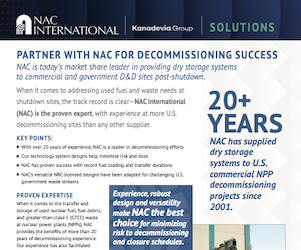Storage Assured

Pioneering Transportable Nuclear Fuel Storage
NAC International holds decades of experience designing, engineering, licensing, operating and maintaining nuclear spent fuel management systems for storage and transport.NAC’s eleven major U.S. Nuclear Regulatory Commission (NRC)-licensed systems include several first-of-their-kind technologies. For example, the STC is the first high-capacity, directly-loaded dual-purpose system licensed for both storage and transport of standard nuclear fuel. The MPC is the first NRC-approved multipurpose storage and transport canister-based system. And MAGNASTOR® is the first ultra-high capacity system to receive its NRC license, and the first loaded with spent fuel.
NAC has designed, licensed and delivered more than 700 transportable nuclear fuel storage systems worldwide, including the industry’s three leading systems: MAGNASTOR, UMS, and MPC.
 NAC has provided dry fuel storage systems for over 20 years to U.S. decommissioning sites, more than any other vendor.
NAC has provided dry fuel storage systems for over 20 years to U.S. decommissioning sites, more than any other vendor.NAC has obtained more than 200 NRC license applications and amendments on storage and transport system designs. This broad range of experience provides assurance that NAC can successfully design, license and fabricate storage and transport technology to meet the requirements of the international nuclear industry.
NAC is a committed long-term provider of spent fuel storage and transport systems, together with the associated and complementary systems and services, to meet the needs of the nuclear industry well into the future.
MAGNASTOR®
MAGNASTOR is a new-generation Multipurpose Canister System that stores between 16 and 28 percent more spent fuel than competing high-capacity licensed systems.Learn More
UMS
UMS was the first U.S. system designed to meet the requirements of almost every U.S. utility, with involvement from U.S. operators and the worldwide fabrication team to ensure its successful launch and production.Learn More
MPC
MPC is designed for storing and transporting spent fuel from older U.S. nuclear plants – which will likely be the first to ship fuel to an interim storage facility.Learn More

 George Vaughan
George Vaughan 


